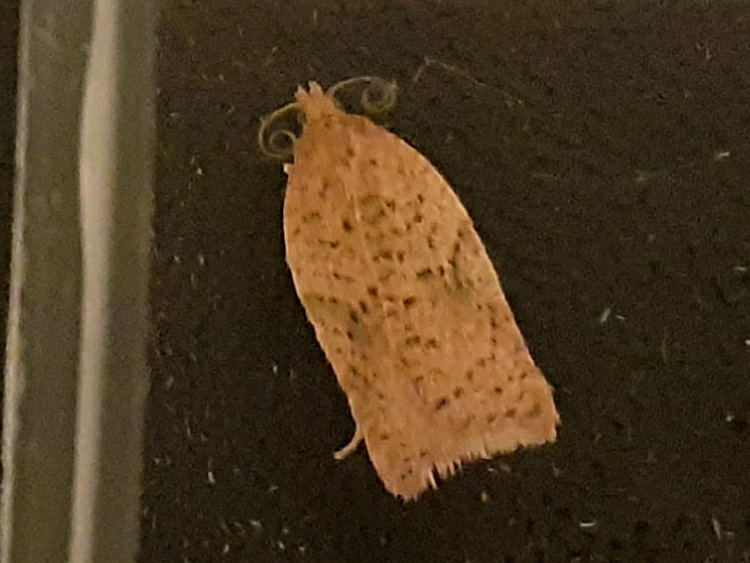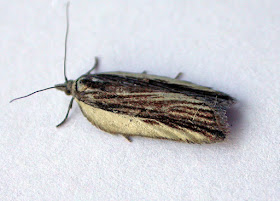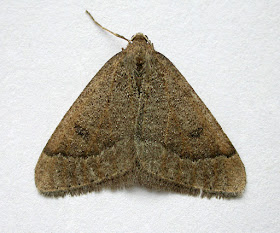Happy New Year one and all. May there be plenty of moths in all of our traps this coming season, although the current weather forecast suggests that those of us who keep recording throughout the winter may have to wait a few days before getting off the mark for 2025!
The lights were on each night throughout the second half of December here in the garden at Westcott but on four occasions they produced a nil return (18th, 19th & 31st thanks to very strong winds but, unexpectedly, also on 30th when conditions were actually quite benign). Otherwise something turned up each time and species seen over this period comprised Ypsolopha ustella, Amblyptilia acanthadactyla, Emmelina monodactyla, Acleris schalleriana, Cypress Carpet, Winter Moth, Pale Brindled Beauty, Mottled Umber & Dark Chestnut, while found indoors were Tineola bisselliella & Mompha epilobiella.
 |
| Ypsolopha ustella, Westcott 29th December |
This two-week period also saw a handful of other insects brought to the overnight lights, including water beetles Colymbetes fuscus (24th) & Dytiscus marginalis (23rd & 24th), predatory shield-bug Troilus luridus (25th) and a seemingly rather early example of ichneumon wasp Ophion variegatus (30th). I get lots of that particular Ophion here, but usually not until mid-January onwards.
That brings activity in the garden to a close for 2024. I don't yet know exactly how many moth species appeared here during the year but the macro count will be somewhere just above 330 and I believe the overall total will be in the high 600s. It is possible that I may just reach the 700+ level achieved in each of the previous three seasons but somehow I doubt it. I do know how many individual moths turned up though, and as expected that total shows a marked reduction over previous years. 26,270 was the total for 2024, which is the lowest count for twelve years and didn't reach half of the number seen here in 2019 for a roughly similar amount of trapping effort. The steady increase in the number of trapping nights which can be seen in the table below is certainly not accounted for by me being absent from the garden any less often (we've been away for three or four weeks altogether in most of the years listed). It appears to be down to our ever-warmer winters providing suitable conditions more and more frequently in January, February and December when moths could be flying, which probably isn't a good thing at all.
|
Year
|
Nights trap was run
|
Micro species
|
Macro species
|
Overall moth count
|
|
2015
|
298
|
309
|
324
|
33,941
|
|
2016
|
289
|
316
|
315
|
26,697
|
|
2017
|
279
|
326
|
336
|
28,189
|
|
2018
|
286
|
346
|
338
|
42,063
|
|
2019
|
323
|
344
|
355
|
54,400
|
|
2020
|
320
|
345
|
330
|
36,784
|
|
2021
|
335
|
380
|
332
|
29,330
|
|
2022
|
326
|
383
|
360
|
38,146
|
|
2023
|
320
|
362
|
350
|
34,986
|
|
2024
|
340
|
|
|
26,270
|
Macro-moth additions to the site list comprised Chamomile Shark & Plumed Fan-foot as well as Spiny Hook-tip (genitalia now checked thanks to Peter Hall). A definitive count for new micros is still awaited but certainly includes Stigmella catharticella, Crassa tinctella & Diurnea lipsiella. The final number of additions is expected to be the lowest here in 20 years of trapping this site but realistically I should be pleased still to be getting any at all after that length of time.
 |
| Chamomile Shark, Westcott 14th April |
 |
| Plumed Fan-foot, Westcott 10th August |
 |
| Spiny Hook-tip, Westcott 1st November (gen det) |
How was your experience of 2024? Did you also find that there was a marked reduction in numbers compared to earlier years?
Dave Wilton Westcott, Bucks





























.jpg)









